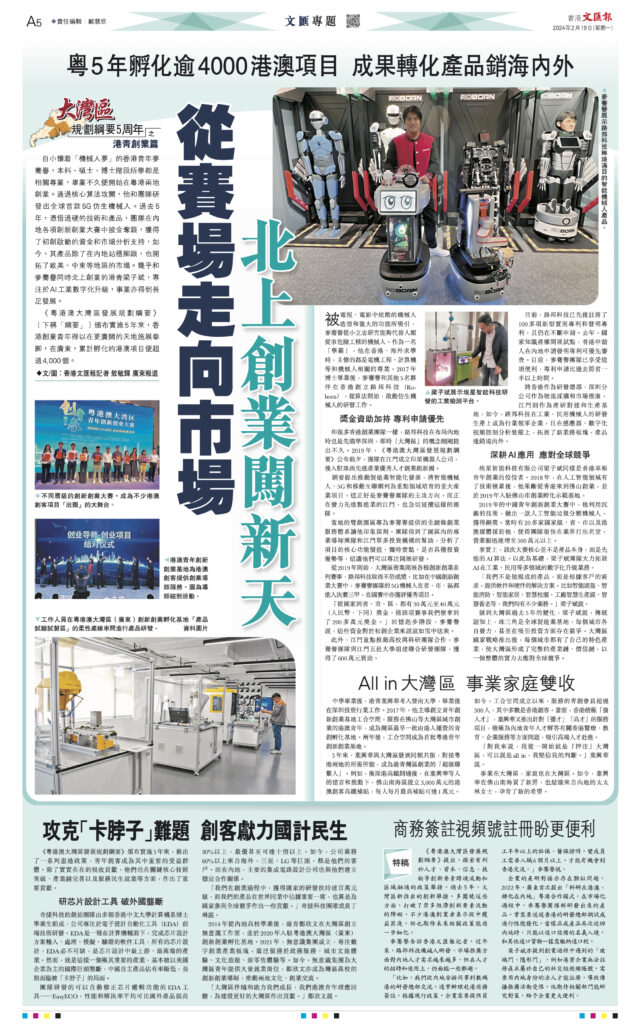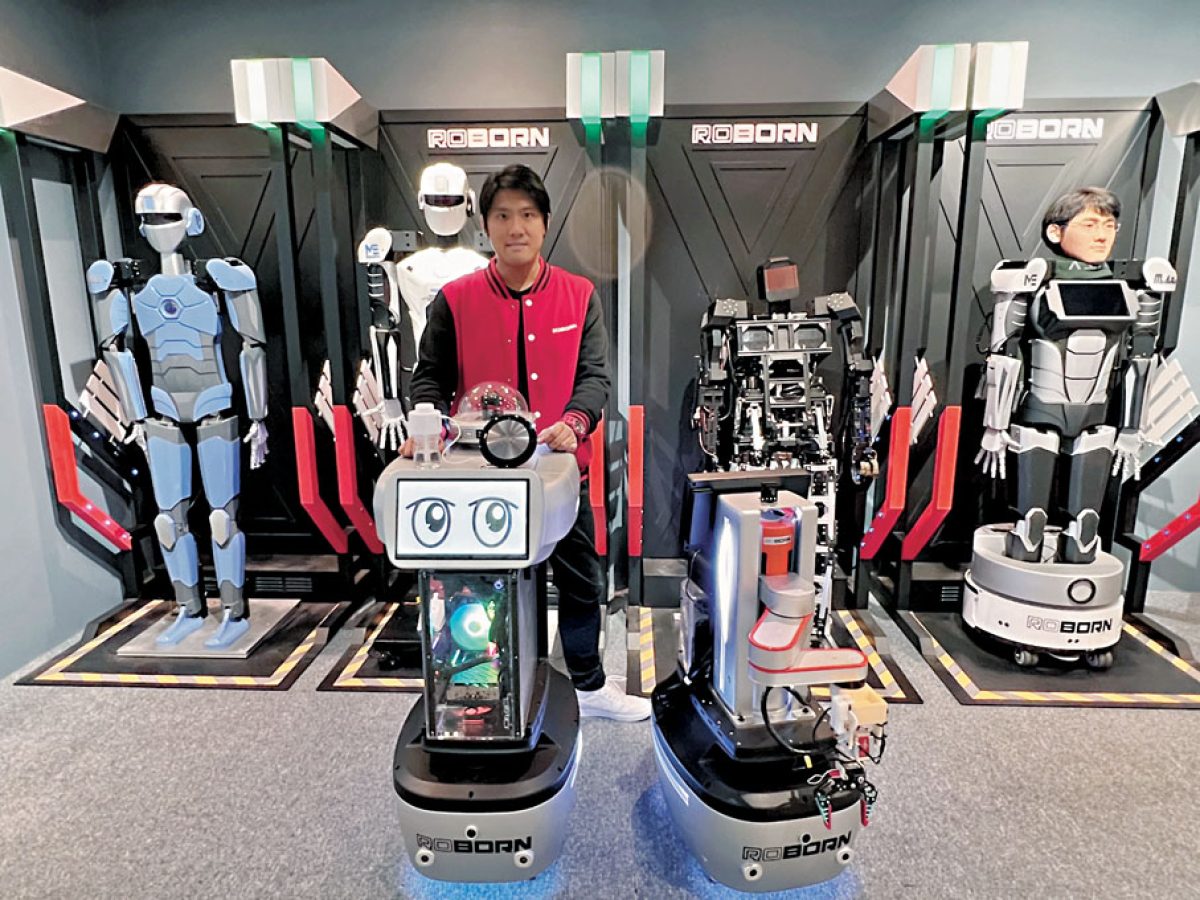Mark Mak, a young Hong Kong entrepreneur who has had a “dream of robotics” since childhood, pursued relevant studies in his undergraduate, master’s, and doctoral stages. Shortly after graduating, he embarked on entrepreneurship in the Guangdong-Hong Kong region. Through core algorithm development, he and his team have developed the world’s first 5G bionic robot. Over the past five years, with their solid technology and products, the team has achieved remarkable success in various innovation and entrepreneurship competitions in mainland China, securing funding and market analysis support for their start-up. Today, their products have not only gained a foothold in mainland China but also expanded into markets in Europe, the Americas, the Middle East, and other regions.
Since the implementation of the “Outline Development Plan for the Guangdong-Hong Kong-Macao Greater Bay Area” (referred to as the “Outline Development Plan”) five years ago, Hong Kong’s young entrepreneurs have been able to showcase their talents in a broader arena. In Guangdong alone, the accumulated number of Hong Kong and Macau projects incubated exceeds 4,000.
Captivated by the cool robotic designs and powerful functionalities depicted in television and movies, Mark was determined to research robots capable of replacing humans in hazardous occupations from a young age. As an academic achiever, he focused on studying electrical engineering, computer science, and other fields related to robotics while studying in Hong Kong and overseas. In 2017, after completing his doctoral degree, Mark and five other partners founded Roborn in Hong Kong, initiating the development of bionic robots starting from algorithms.
Bonus Funding Boosts with Priority Patent Applications
Like many Hong Kong entrepreneurial teams, Roborn targeted Shenzhen first when expanding into mainland China, shortly after the concept of the Greater Bay Area had been introduced. In 2019, on the eve of the release of the “Outline Development Plan for the Guangdong-Hong Kong-Macao Greater Bay Area,” the team established the company Roborn (Jiangmen) in Jiangmen. It later settled in the Zhuxi Advanced Industrial Talents Entrepreneurship and Innovation Park.
The “Outline Development Plan” proposes to promote the intelligent development of the manufacturing industry, identifying intelligent robots, 5G, and mobile Internet as key areas for cultivating major industrial projects. This aligns perfectly with the focus of Mark’s team. Jiangmen, which is actively promoting advanced manufacturing, eagerly sought to attract such teams.
The local innovation and entrepreneurship park provided a comprehensive entrepreneurial service system for Mark, leaving a deep impression on him. The team received assistance from the park’s professional mentor team and numerous investment institutions in Jiangmen, who analyzed the project’s core functional value, unique selling points, and investment advantages. This allowed them to focus on research and development.
Since 2019, the Greater Bay Area has hosted various innovation and entrepreneurship competitions, in which Roborn has achieved remarkable results. For example, in the China Innovation and Entrepreneurship Competition, Mark’s team’s 5G robot reached the top three in the provincial, city, and district finals. It was also recognized as an excellent project in the national competition.
“From the national level to the provincial, city, and district levels, there were cash prizes ranging from 300,000 to 400,000 RMB (Renminbi, Chinese currency). In that competition alone, we received over 2 million RMB in prize money,” Mark recalled, highlighting how these funds were like a lifeline for a start-up company.
In addition, Jiangmen focuses on promoting collaborations between universities and research teams, Mark’s team formed a joint research and development team with Jiangmen Wuyi University and received 6 million RMB in funding.
Currently, Roborn has registered over 100 new utility patents and invention patents and continues to file new applications. Last year, a pilot program was launched for intellectual property rights in China, allowing Hong Kong applicants to receive priority examinations for patent applications in mainland China. Mark’s team has already benefited from this convenience, reducing the time required for patent applications by more than half.
With Hong Kong serving as the research and development headquarters, Shenzhen as the logistics procurement and market promotion branch, and Jiangmen as the production and research integration and manufacturing base, Roborn has become a leading enterprise in the industrial and civil robotics sector. They have also expanded into new business sectors such as sensors and digital video control and analysis equipment, with their products being exported domestically and internationally.

[Feature article] Simplifying Registration of Business Video Accounts for Greater Convenience
The “Outline Development Plan for the Guangdong-Hong Kong-Macao Greater Bay Area” proposes exploring policies and measures that facilitate the cross-border flow and regional integration of innovative elements such as talent, capital, information, and technology. Over the past five years, numerous innovative initiatives in the Greater Bay Area have focused on breaking down barriers to the flow of these innovative elements. Many entrepreneurs from Hong Kong and Macau have benefited greatly from these initiatives but also hope that future related policies can be further refined.
Mark Mak, CEO of Roborn, told a reporter from Hong Kong Wen Wei Po that in recent years, there has been an increasing demand for talent in the research and development as well as market promotion of their robotics technology in mainland China. However, they still face some challenges in terms of talent recruitment and utilization.
“For example, when we arrange for colleagues from mainland China to visit our research and development headquarters in Hong Kong, we usually need to apply for business visas. According to the current policy, companies need to provide proof of social security and medical insurance for employees. This means that employees need to be employed for at least six months before they have the opportunity to come to Hong Kong for exchange,” Mark said.
Similar problems also exist in the connection between production and research. In 2022, Guangdong proposed the “Research in Hong Kong and Macau, Transformation in Mainland China” cooperation model. During the marketization process, the new products developed by Mark’s team often require debugging or performance optimization at the research and development headquarters in Hong Kong. However, when the samples or products are sent back to mainland China, they can only enter as imported equipment and are subject to import duties, just like other imported goods.
Reference:
(Website)
[Feature article] Simplifying Registration of Business Video Accounts for Greater Convenience
(PDF)

